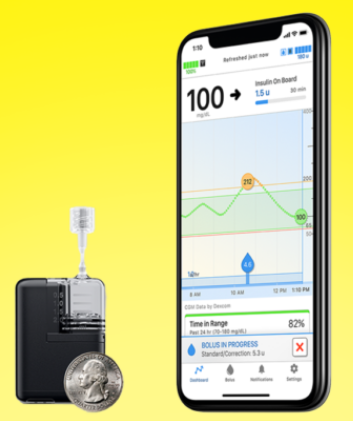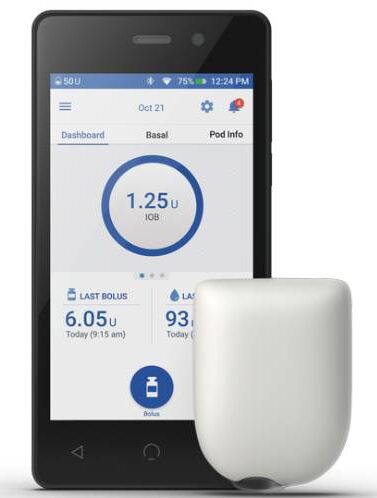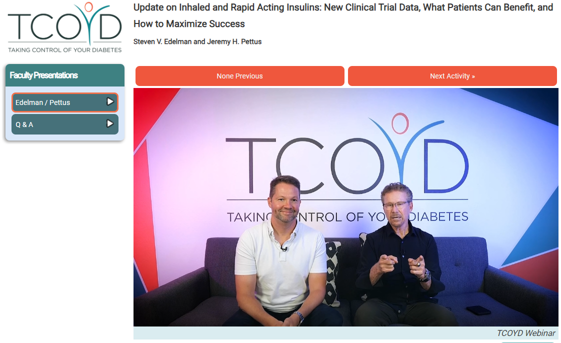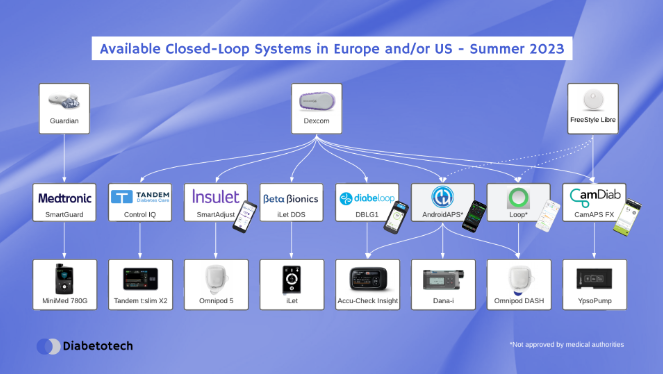FDA clears Tandem Diabetes Care’s Mobi durable automated insulin pump by Sean Whooley for DrugDeliveryBusiness.com, 11 July 2023.
 Tandem Diabetes Care announced that the FDA cleared its Tandem Mobi automated insulin delivery (AID) system. Clearance covers people with diabetes ages six and up, expanding the Tandem portfolio of products. San Diego-based Tandem says Mobi, which is fully controllable from a mobile app, is the world’s smallest durable AID system. Mobi features a 200-unit insulin cartridge and an on-pump button to provide an alternative to phone control for insulin boluses. It comes in at less than half the size of the existing Tandem pump system, the t:slim X2 pump. According to the company, it can fit in a coin pocket, clip to clothing or go on the body with an adhesive sleeve.
Tandem Diabetes Care announced that the FDA cleared its Tandem Mobi automated insulin delivery (AID) system. Clearance covers people with diabetes ages six and up, expanding the Tandem portfolio of products. San Diego-based Tandem says Mobi, which is fully controllable from a mobile app, is the world’s smallest durable AID system. Mobi features a 200-unit insulin cartridge and an on-pump button to provide an alternative to phone control for insulin boluses. It comes in at less than half the size of the existing Tandem pump system, the t:slim X2 pump. According to the company, it can fit in a coin pocket, clip to clothing or go on the body with an adhesive sleeve.
Tandem Mobi also comes with detachable infusion sets compatible with all existing Tandem-branded infusion sets manufactured by Convatec. This also includes a new five-inch tubing option made just for the Mobi system. The infusion sets allow users to temporarily disconnect from their pump for convenience. According to the company, they offer the flexibility of more than 30 mix-and-match infusion site and tubing length combinations.
Mobi also features Tandem’s Control-IQ technology for automated insulin delivery. Control-IQ, a hybrid closed-loop algorithm, uses compatible continuous glucose monitor (CGM) sensor values to predict glucose levels 30 minutes ahead. Every five minutes, the algorithm adjusts insulin delivery to prevent highs and lows. It still enables the user to manually bolus for meals while delivering automatic correction boluses to prevent hyperglycemia. The mobile app control enables full iOS command through a compatible iPhone. Modern features include water resistance, inductive charging and wireless remote software updates, too.
Tandem plans to conduct a limited release of Mobi in late 2023. The company intends to make it fully available in early 2024.
Read more: FDA clears Tandem Diabetes Care’s Mobi durable automated insulin pump
Insulet announces 510(k) submission of Omnipod 5 iOS smartphone app and initiation of OUS trial with FreeStyle Libre 2 by Closer Look/CloseConcerns.com, 22 June 2023.
Insulet announced that they:
-
-
- have submitted an Omnipod 5 iPhone app to the FDA for 510(k) clearance, which will provide full smartphone control for those using the company’s AID system, and
- “will soon begin enrollment” of a clinical study to advance its CGM integration efforts with Abbott’s FreeStyle Libre franchise.
-
 On the Omnipod 5 app, users can (i) set their basal 24-hour profile, their target glucose (110-150 mg/dl) 24-hour profile, and their bolus settings; (ii) activate and deactivate their Pods; (iii) start and stop Auto Mode; (iv) enable the Activity feature (temporary target of 150 mg/dl); (v) connect to their CGM; (vi) view their insulin delivery and CGM history; and (vii) respond to alerts and alarms. According to the company, the user interface of the app has been “enhanced” to better align with the Apple iOS ecosystem. Insulet has also added a new “Custom Food feature” to the iOS app including “meal detection, late meal entry, lower targets and tighter control, and cloud-based algorithm tuning.”
On the Omnipod 5 app, users can (i) set their basal 24-hour profile, their target glucose (110-150 mg/dl) 24-hour profile, and their bolus settings; (ii) activate and deactivate their Pods; (iii) start and stop Auto Mode; (iv) enable the Activity feature (temporary target of 150 mg/dl); (v) connect to their CGM; (vi) view their insulin delivery and CGM history; and (vii) respond to alerts and alarms. According to the company, the user interface of the app has been “enhanced” to better align with the Apple iOS ecosystem. Insulet has also added a new “Custom Food feature” to the iOS app including “meal detection, late meal entry, lower targets and tighter control, and cloud-based algorithm tuning.”
Insulet also announced that it is progressing with the company’s eventual goal of supporting multiple CGMs for Omnipod 5 by soon beginning enrollment of a clinical study with Omnipod 5 and FreeStyle Libre 2. The trial, which will soon begin enrollment, will recruit “up to 200 participants with type 1 diabetes in both the adult and pediatric age groups in the United Kingdom, France, and Belgium.” The primary endpoint of the study will be A1c, and the trial design will be intended to demonstrate the superior efficacy of Omnipod 5 compared to MDI.
The integration of Omnipod 5 with Dexcom G7 went unmentioned in the press announcement. We learned that Insulet will launch Omnipod 5 in Germany in fall 2023 with Dexcom G6, suggesting that this integration maybe won’t happen until 2024.
Some EXECUTIVE HIGHLIGHTS from Friends for Life 2023, Orlando, FL, 7 June 2023, presented by Close Concerns Closer Look Newsletter.
 THREE great presentations by the University of Washington’s Dr. Irl Hirsch:
THREE great presentations by the University of Washington’s Dr. Irl Hirsch:
-
- A1c vs. GMI/Time in Range: Dr. Hirsch offered an analysis of the limitations of relying on A1c and instead proposed that GMI and Time in Range should co-exist with A1c as the standard metrics of glycemic management, with an eye toward individualization;
- Dr. Hirsch said that the problem with A1c measurements is that they are easily influenced by a multitude of factors – many of which are unrelated to diabetes. Specifically, he said that the survival rate of red blood cells profoundly influences A1c as people with short-surviving red blood cells tend to have higher A1cs, while those with red blood cells that survive for longer tend to have lower A1cs. Moreover, glycation rates, which are unique for each individual, can also influence A1c, and variation in these rates is “clinically important” for A1c measurements. Dr. Hirsch said that these factors, which are presumed to be largely genetic, have “nothing to do with diabetes management,” indicating the limitations in using A1c as a marker of glycemic management. However, he conceded the world will be A1c-centric “for a long time” until everyone can access CGM – a goal that remains far away from reality.
- Dr. Hirsch said that GMI and Time in Range should eventually replace A1c as the benchmark assessment of glycemic management; however, he concluded that currently, these metrics must “co-exist” with A1c. He said current and future CGMs provide a “more accurate and granular assessment” of glycemic management than A1c, and CGM metrics will work with all populations, unlike A1c, which is directly influenced by race, ethnicity, and other health conditions. However, Dr. Hirsch emphasized that CGMs need to become more accurate, affordable, and ideally non-invasive. Additionally, uptake with regulatory agencies and nonspecialist HCPs needs to improve significantly.
Moreover, regulatory agencies and insurers still require A1c measurements in major RCTs (Randomized Control Trials) to support the efficacy of a new therapy or technology. While Dr. Hirsch cautioned that A1c is not particularly informative for individuals’ glycemic control, he did say A1c is a “powerful metric” to assess glycemic control and complications in a population. - Dr. Hirsch discussed the need for individualized A1c targets and suggested that quantifying A1c’s discordance from GMI can help adjust these targets. He highlighted data from CGM users (n=641) in which 50% of participants had ≥0.5% difference between their GMI and A1c. While the discordance between A1c and GMI may be due to individual differences in red blood cell lifespan and glycation rates, Dr. Hirsch suggested that more work is needed to determine
if these two factors are related or independent … and that this discordance could be used to potentially predict risk for microvascular complications by analyzing glycemic ratio (GMI/A1c). A recently completed study revealed that individuals with a glycemic ratio <0.9 (whom Dr. Hirsch called “fast glycators”) had more than a two-fold increased risk for developing retinopathy (OR=2.05; p=0.001) and nearly a three-fold increased risk for developing nephropathy (OR=2.83; p=0.0001), compared to those with a glycemic ratio >0.9 (“slow glycators”). Thus, using GMI may provide additional insight that helps individualize A1c targets according to their glycemic ratio to better suit the needs of PWD.
- NEW therapies (other than insulin) for T1D: Dr. Hirsch also discussed his hopes for the approval of therapies other than insulin, including SGLT-2s, GLP-1s, and others;
- Dr. Hirsch hopes for approval of therapies other than insulin. Even though most people with type 1 diabetes are currently on insulin, several problems exist:
- Average A1c levels rose from 2010-2012 to 2016-2018;
- Disparities in A1c reductions exist by race, with Black people with diabetes having the highest average A1c;
- Obesity is becoming an increasingly important issue in T1D populations, with no differences in obesity rates between people with T1D achieving glycemic goals and the general population. Therapies approved over the last couple of decades for type 2 diabetes (T2D), such as SGLT-2 inhibitors and GLP-1 receptor agonists, have shown striking A1c reductions, weight loss, and reduced risk of CV complications, but unfortunately, people with T1D must primarily rely on off-label prescriptions for these treatments. Dr. Hirsch said that the lack of FDA approval for T1D has immense implications: even though drugs indicated for T2D (like Ozempic) can be prescribed to anyone, he characterized it as highly unlikely that their pricing will be covered by insurance. Given how some of these more potent therapies can be >$1000/month, only a small minority of people with T1D use them.
- Multiple T2D therapies, which target different metabolic pathways, may have promising applications for people with T1D. While Metformin is a low-cost medication and is usually the first-line agent in T2D. However, it was found that metformin doesn’t confer significant benefits for people with T1D. SGLT-2 inhibitors, acting independently of beta-cell function, have shown ~0.4% A1c reductions and four to seven pounds of weight loss. Additionally, GLP1s, which reduce satiety signals in the brain and inhibit glucagon activity, were particularly effective in people with type 1 diabetes who were still producing C-peptides. Thus, Dr. Hirsch was “very disappointed” that therapies like semaglutide have recently stopped being tested for glucose control in people with T1D. “I want to see these drugs available for everyone,” said Dr. Hirsch. Given that one of the major barriers to safe use for all with T1D for SGLT-2s is an increased risk of euglycemic DKA (eDKA), this use will become far more possible once continuous ketone monitoring (CKM) is approved. In fact, the risk of eDKA is said to be two to four times higher with this class compared to placebo. Dr. Hirsch expressed optimism that eDKA can be mitigated using CKM, paving the way for SGLT-2 usage in T1D.
- A new drug candidate Dr. Hirsch mentioned was REMD Biotherapeutics’ volagidemab – one of a class called “glucagon receptor antagonist,” which has been used with SGLT-2s in type 1 diabetes. Notably, a phase 1/2 study of this combination therapy showed improvements in Time in Range while reducing SGLT-2-induced ketogenesis. Dr. Hirsch is excited about the potential for these therapies to treat both diabetes and the cardio-renal complications of type 1 diabetes.
- Dr. Hirsch hopes for approval of therapies other than insulin. Even though most people with type 1 diabetes are currently on insulin, several problems exist:
- T1D and Aging: He explained the unique needs and challenges older adults with T1D face, describing the “tsunami” of people with T1D getting ready to retire and/or enter assisted living.
-
- In his third consecutive talk of the day, Dr. Hirsch brought attention to the need to better understand and care for older adults with T1D. There is a “tsunami” of people with T1D getting ready to retire and/or enter assisted living, and Dr. Hirsch expressed his concern for how unprepared the US healthcare system may be to serve these people. With ≥35% of his patients on Medicare, Dr. Hirsch voiced what he believes is a need to educate geriatricians about T1D, given how few specialists there are. From the landmark DCCT study, the field certainly knows very well that improved glycemic control results in a longer life span on average, but what does diabetes care for older people look like, and what additional nuances will their care require?
- In explaining the reasons for type 1 diabetes mortality, Dr. Hirsch highlighted how treatments for older people with T1D should look different from other ages. According to a study published in JAMA, Dr. Hirsch said that the number one cause of type 1 diabetes mortality is cardiovascular disease (CVD) (22.4%), followed by cancer (19.6%), hypoglycemia/DKA (17.8%), and accident or suicide (16.8%). Even though these percentages are much lower now, CVD remains a health concern for older people with type 1 diabetes, and significant mental health challenges – including depression and anxiety – continue to burden patients. Whereas the main treatment concerns for children and adolescents/young adults are A1c levels and glycemic management, Dr. Hirsch advocated that blood pressure (BP) and lipid content (e.g., LDL cholesterol) should be a greater priority when treating older adults (childhood-onset) with T1D. This is why, according to Dr. Hirsch, statins are some of the most important drugs that have contributed to the longevity of older patients with T1D – it should be a no-brainer for these patients to get the drugs and to hear frequently about the importance of adherence.
- Dr. Hirsch explained the unique targets for older adults with type 1 diabetes and the benefits of glycemic control early on. Adults 40+ should aim for:
- LDL-cholesterol levels under 70 mg/dL;
- BP under 130/80, but even lower for patients with known kidney disease;
- A1c <7%, or Time in Range of ~70%
- Time below Range <1%, especially if above 80 years old, since longer Time Below Range increases the risk of cognitive decline. Dr. Hirsch emphasized that actively managing glucose levels during the early stages of T1D diagnosis has significant benefits later on. However, in a process known as metabolic amnesia, these long-term benefits can wear off, despite the clear advantages of early treatment.
- In conclusion, Dr. Hirsch said that the biggest enemy of older adults with type 1 diabetes is severe hypoglycemia, which can lead to cognitive impairment and frailty. Dr. Hirsch explained that hypoglycemia is a much greater enemy for older people with T1D compared to younger patients, leading to rapid cognitive decline. This association is bidirectional as well: as patients become more cognitively impaired, they may accidentally take their insulin twice, leading to hypoglycemia, or forget their insulin, leading to hyperglycemia. Additionally, hypoglycemia can also lead to changes in morbidity – namely increased frailty – which can then lead to increased hypoglycemia in a negative feedback loop.
- Dr. Hirsch believes that it is important to appreciate when additional assistance for older people with type 1 diabetes is required, and more geriatricians need to be educated about type 1 diabetes. While some hope that “geriatric type 1 diabetes” will become a growing field of interest, this may not happen without intentional focus and a means to motivate those in training now.
-
- A1c vs. GMI/Time in Range: Dr. Hirsch offered an analysis of the limitations of relying on A1c and instead proposed that GMI and Time in Range should co-exist with A1c as the standard metrics of glycemic management, with an eye toward individualization;
Barbara Davis Center’s Dr. Viral Shah, who championed ready-to-use glucagon
 Dr. Viral Shah led a most-valuable presentation on diabetes complications, which aimed to make people with diabetes and their caregivers more knowledgeable about diabetes-related complications. He provided a very accessible overview of acute complications (diabetic ketoacidosis and severe hypoglycemia) and chronic microvascular (retinopathy, nephropathy, and neuropathy), and non-vascular complications (musculoskeletal problems). He emphasized the importance of prevention of these complications and presented actionable steps people with diabetes can use to prevent the development of various complications.
Dr. Viral Shah led a most-valuable presentation on diabetes complications, which aimed to make people with diabetes and their caregivers more knowledgeable about diabetes-related complications. He provided a very accessible overview of acute complications (diabetic ketoacidosis and severe hypoglycemia) and chronic microvascular (retinopathy, nephropathy, and neuropathy), and non-vascular complications (musculoskeletal problems). He emphasized the importance of prevention of these complications and presented actionable steps people with diabetes can use to prevent the development of various complications.
-
- Dr. Shah encouraged attendees to “always carry glucagon” in their diabetes toolkits to prevent severe hypoglycemia. Dr. Shah said he hears some patients explain that they do not carry glucagon because “they never use it”, but he stressed that he always encourages them to carry it because “you’ll never know when you need to use it”.
- Dr. Shah encouraged attendees to think from a “family perspective” rather than a “personal perspective” when purchasing glucagon. When glucagon is needed, Dr. Shah said that glucagon is most often not administered by the person with diabetes themselves because they are usually not in a state to use it. Thus, while injectable forms of glucagon may be familiar for people with diabetes and their caregivers, roommates and work colleagues may not be comfortable using traditional needles, to say nothing of historical products that needed premixing, which has prevented effective and timely glucagon use in countless emergencies. Dr. Shah recommended ready-to-use forms of glucagon, specifically Xeris’ Gvoke and Lilly’s Baqsimi because they are pre-mixed and therefore easier to quickly use. On Baqsimi specifically, he noted its nasal administration may be more comfortable for people averse to using needles. Importantly, Dr. Shah does not recommend traditional glucagon emergency kits because of the time required to mix the glucagon and its higher rate of administration errors.
Update on Inhaled and Rapid Acting Insulins with Drs. Steve Edelman and Jeremy Pettus for TCOYD.WebEdCafe.com.
Click here for video: Update on Inhaled and Rapid Acting Insulins
Use of AI in predicting complications, outcomes in diabetes care by Erin T. Welsh for Healio.com/endocrinology, 25 June 2023.
 In this video exclusive, David C. Klonoff, MD, FACP, FRCP (Edin), Fellow AIMBE, discusses the potential for data and AI to improve diabetes care. Klonoff is clinical professor of medicine at the University of California San Francisco and medical director of the Dorothy L. and James E. Frank Diabetes Research Institute of Mills-Peninsula Medical Center. Klonoff describes using AI in diabetes to predict complications and outcomes.
In this video exclusive, David C. Klonoff, MD, FACP, FRCP (Edin), Fellow AIMBE, discusses the potential for data and AI to improve diabetes care. Klonoff is clinical professor of medicine at the University of California San Francisco and medical director of the Dorothy L. and James E. Frank Diabetes Research Institute of Mills-Peninsula Medical Center. Klonoff describes using AI in diabetes to predict complications and outcomes.
“Artificial intelligence is going to help people with diabetes a lot,” said Klonoff. “It’s going to find ways of taking data that we’re not used to assembling and putting together in intelligent ways. When we do that, we’ll be able to make better diagnoses, better predictions, and select better treatments.”
VIDEO: Use of AI in predicting complications, outcomes in diabetes care
Available Closed-Loop Systems in Europe and/or US, as of Summer 2023, posted by Dr. Inge Van Boxelaer on her website, Diabetotech.com/en.
This is a current “snapshot” of closed-loop systems in the world. PLEASE note that there are ONLY 4 commercially available systems available to T1Ds in the US … EU has 8!!! WHY??? Hello, FDA?!?!?
Of course, the DIY offerings are available and supported (better than any commercial systems) worldwide: Loop, AAPS, iAPS. And there is significantly more patient data collected and available on these DIY systems than all of the commercial systems combined.
To subscribe to Dr. Van Boxelaer’s newsletter, Diabetotech: Diabetotech.com




I remain concerned about the Mobi. Not quite a patch pump, not quit a pocket pump. I do personally think it is a pump without a need. We will see.
The big winner here is Dexcom, the great loser so far is Freesyle. assuming Medtornic can hold out, it may portend the demise of freestyle in the T1 market. which means the world will remain pretty much the same. When will Medtronic get tired of being squeezed, and instead start buying market share by releasing the guardian more widely? Only time will tell.